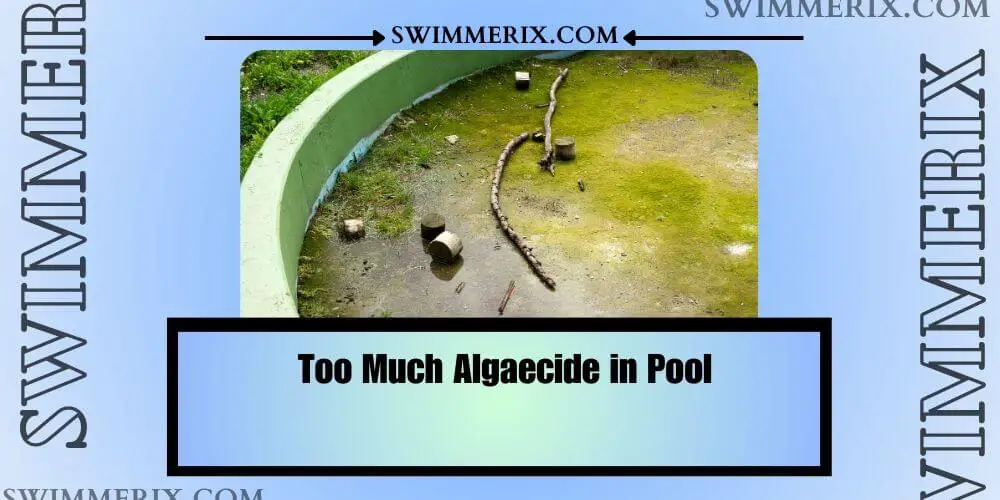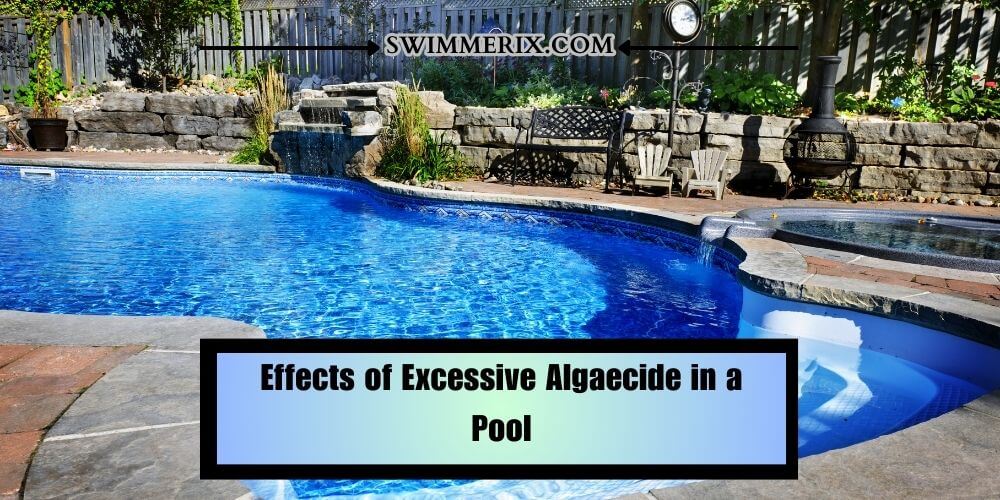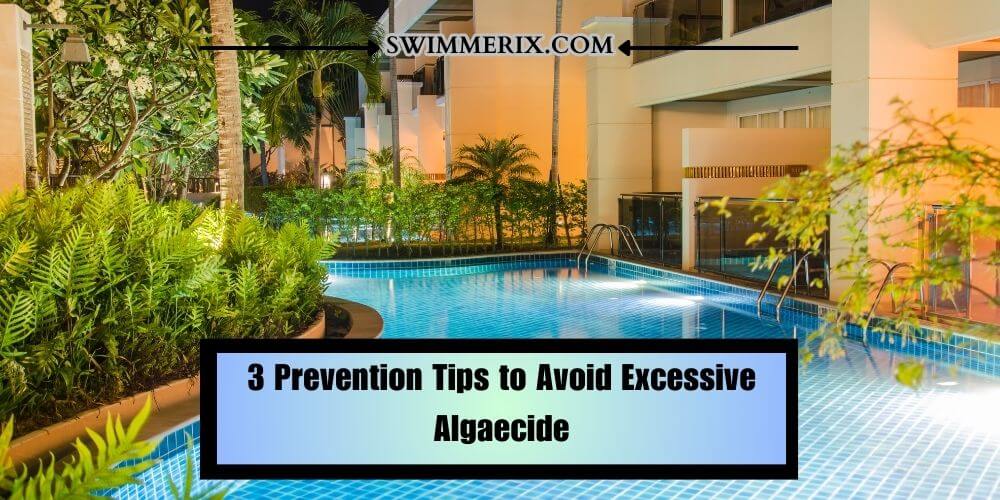
You must pay attention to the pool maintenance to ensure a clean & safe swimming environment for you, your family & your friends. However, suppose you are concerned about algae growth like Brown Algae in Pool, but accidentally used too many algaecide in pool.
In that case, it will adversely affect water chemistry pool equipment and swimmers’ health. To help you cope with this & find an appropriate solution, I have written this article where you will be exploring the consequences of excessive algaecide and three effective solutions along with prevention tips to maintain a pristine pool.
But before I tell you all of these things, I will advise you first to consult a professional who can assess the situation better or use a water testing kit to determine the excessiveness of the algaecide in your pool. Now, coming back to the topic of too much algaecide in a pool, let’s first understand the effect of excessive algaecide.
Effects of Excessive Algaecide in a Pool

You must find the right balance to maintain the pool effectively. Using too many algaecides will further disturb the delicate equilibrium of your pool water chemistry, leading to undesirable consequences that may impact the pool, its equipment, and the swimmers’ health.
Impact on Water Chemistry
Increased Levels of Chemicals
Well, if you have used excessive algaecides, You Are Not alone. People may have complained about using too many algaecides in a pool, leading to an overabundance of chemicals in the pool water.
However, you should know that this imbalance will lead to cloudiness forming and a strong chemical odor coming from the pool, making it inviting and potentially harmful to swimmers. Therefore, you should only step into your pool if there are enough algaecides.
Imbalance in pH & Alkalinity
Another common issue due to the high amount of algaecides in a pool that you might observe in the water perimeter is imbalances in pH & Alkalinity. You should know that algaecides contain active ingredients that directly affect the pH & alkalinity level.
If you pour overdose on algaecides, it will further lead a pH level drop, making the water acidic & not safe for anyone or anything. This kind of acidity damages your pool equipment and causes skin & eye irritation to swimmers & especially to people with sensitive skin or oversensitive immune systems. Hence, consider learning “How to Raise pH Without Raising Alkalinity“
To address this kind of issue & maintain a healthy swimming environment, you need to act promptly to find a perfect remedy for the situation, which we will discuss later in this article.
Damage to Pool Equipment
Too much algaecide affects the water chemistry and can lead to various issues with your pool equipment.
Corrosion of Metal Parts
Another common issue you might experience after adding Too Much Algaecide in Pool are the corrosion process’s acceleration, particularly in metal parts like ladders, railings, and pump components.
You should know that the corrosive nature of algaecides can effectively cause these parts to deteriorate more rapidly, leading to costly repairs or replacement. Therefore, to cope with that, immediately find a prompt remedy for the situation.
Clogging of Filters
Another potential pool equipment damage after applying excessive algaecides can be filter clogging or Pool Sand Filter Not Filtering Algae. You should already note that algaecides contain chemicals & additives that can contribute to filter clogging.
If your filters become clogged, the water circulation in your pool will be compromised, resulting in reduced efficiency & potential damage to the filtration system. This kind of equipment-related problem will significantly impact the longevity & functionality of your pool, underscoring the importance of proper algaecides usage.
Harmful Effects on Swimmers
The excessive use of algaecide can have direct consequences on the health & well-being of swimmers.
Skin & Eye Irritation
As I told you earlier in the above section, overdosing on algaecides can cause skin rashes, itching, and eye irritation in swimmers, especially those with over-sensitive skin. The algaecide chemical may react with other natural oils on our skin, leading to further discount and potential allergic reactions.
Respiratory Problems
It would help if you never breathed in the fumes of an over-chlorine pool, as it may irritate your respiratory system. And unfortunately, excessive algaecide use exacerbates this issue as the increased chemical composition in the pool water releases more fumes into the air. To prevent the adverse effect of excessive algaecides, I’m mentioning some proper solutions to ensure a safe & enjoyable experience for everyone.
Solutions for Removing Excessive Algaecide
After knowing what will happen if you use too many algaecides in your pool, it is important to know how to address this issue using proactive measures. Below I’m mentioning some tips to balance algaecides and eliminate the excess chemicals to rectify the situation better. You can use any of the three effective solutions depending on your preference & specific situation.
Dilution & Dilution Ratios
This is quite an effective method to address excessive algaecides in a pool. You first need to determine the concentration of algaecides in your pool water & check the algaecides level for the recommended dosage per gallon or the concentration percentage.
You can also use this information to calculate the required dilution ratio. After calculating the dilution ratio, you must carefully measure the amount of water & algaecides needed to create the mixture.
Ensure you are not over-measuring anything and gradually introduce the diluted mixture into your pool to ensure thorough mixing & distribution of algaecides evenly. You should know that dilution is a very effective method in reducing the concentration of algaecides in any pool & restoring the proper chemical balance.
Partial Water Replacement
Another method that can help dilute the excess algaecides & algaecides in a healthy environment for swimming is said to be partial water replacement. Suppose you want to reduce the concentration of algaecides using this method.
In that case, you first need to calculate the percentage of water needed to be replaced based on the volume of your pool & the level of algaecides overseas. After calculating the percentage of water required, you need to begin by draining the calculated percentage of water from the pool.
Once you have cleaned it successfully, refill the pool with fresh water from a clean source. Also, ensure the proper PH & chemical balance during the refill process. Also, ‘how soon can you swim in a newly filled pool’ particularly depends upon factors including balance water chemicals & water parameters.
Using Activated Carbon or Pool Clarifiers
Lastly, using activated carbon or pool clarifiers is another effective method to address or remove excess algaecides while enhancing the overall water clarity. Many activated carbon types are available as granules or blocks, which can absorb excess algaecides from the water.
You need to place the activated carbon in a filter bag or a separate chamber to facilitate contact between the carbon & the pool water. Do follow the manufacturer’s instructions for using this kind of technique.
On the other hand, if you are using pool clarifiers specially designed to improve water clarity by aggregating microscopic particles, including excess algaecides, follow the manufacturer’s instructions when adding an appropriate amount to your pool water. Sometime people use bleach, but the question is “Will Bleach Kill Algae in a Pool“. To some extent, yes, but no when algae growth is sever.
3 Prevention Tips to Avoid Excessive Algaecide

When it comes to maintaining a healthy pool environment & safe swimming experience, prevention is always better than cure. Below I mention some essential prevention tips to avoid the hassle of dealing with excessive algaecides or any other chemical composition and its potential consequences.
Regular Pool Maintenance
Pay attention to the regular pool maintenance that keeps the water clean & prevents the need for excessive algaecides. You must monitor & balance the chemical levels in the right way.
To do that, you must find a reliable testing kit & test your pool water to ensure the proper chemical balance. Also, maintain appropriate chlorine levels, pH, Alkalinity, & cyanuric acid according to the recommended range.
You must pay attention to regular brushing and vacuuming your pool to remove debris & prevent the growth of algae. You should also pay particular attention to corners, crevices, & other hard-to-reach areas of your pool where algae can thrive easily.
Proper Algaecide Dosage
If you want to maintain the white balance of algaecides & ensure a healthy pool environment, follow proper dosage guidelines. It would help if you never overused algaecides & pay attention to recommended dosage guidelines based on your pool volume & the severity of the algae problem.
If you are a newbie or uncertain about the appropriate algaecides dosage, it’s best if you consult a pool professional. Pool professionals will help you provide expert advice tailored to your pool’s conditions & algae situations.
Algaecide Alternatives
There are also many types of natural remedies for algae control. Therefore, consider exploring alternate methods of algae control to reduce the need for excessive algaecides use while maintaining a healthy pool environment.
People have been using UV sterilization or ozone systems, but let’s first discuss natural remedies. There are many natural alternative options to chemical algaecides like beneficial bacteria, additives enzymes, and copper ionizers to help control algae growth without excessive chemical treatment.
On the other hand, you can also consider installing UV sterilization. My friend has also used an ozone system to supplement its pool sanitization. This kind of system utilizes ultraviolet rays or ozone gas to kill algae & other microorganisms, which ultimately reduces the Reliance on algaecides.
Conclusion
Maintaining the proper balance of algaecides in your pool is very important for the well-being of swimmers and the longevity of your pool surface equipment & environment. I have given my best to give you in-depth information on what to do if there is ‘too much algaecide in the pool.’
Ensure you understand the consequences of excessive algaecides and implement the solution in the prevention tips mentioned in this article to enjoy a pristine pool that provides a refreshing & safe oasis all summer.
Always remember to follow prevention & regular maintenance for a sparking algae-free pool. If you find this article helpful, where I have shared in-depth information on what to do in case of too much algaecide in the pool, consider sharing it.
Your share will help people learn what to do if there are excessive algaecides in a pool and the bad consequences of not measuring the right amount of algaecides to use in the pool. Check my other helpful guide on pool care & maintenance shared on this website. See you in the next post, till then take care, & goodbye.

